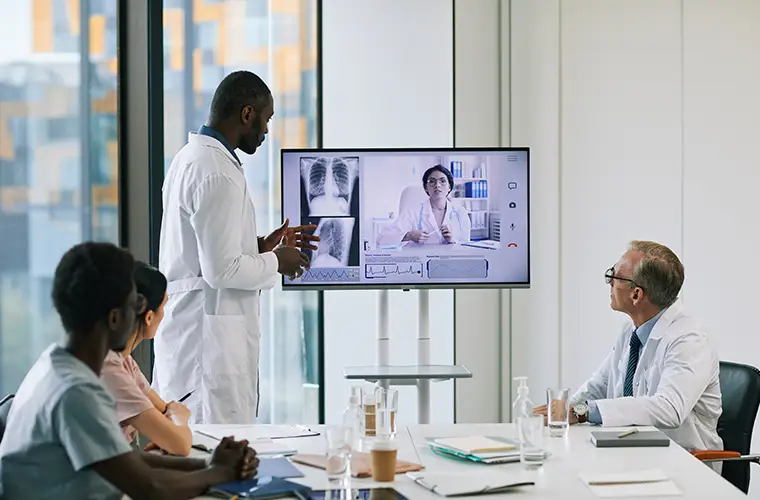Digital transformation & cybersecurity
This year, we have redefined the company’s strategy based on three principles: patient experience, health, and efficiency, with digital transformation as the tool that supports us in all the changes we are making to the care model. This transformation will enable us to move toward increasingly agile, responsive, safe, appropriate, and value-based care.
Defining the medicine of the future
It is clear that digitalization, which some of our centers have pioneered, is here to stay and help transform our care processes, making them more agile and transparent, safer, and more patient-oriented.
We are driving digital transformation on multiple levels: we develop digital applications as well as new IT and process strategies for healthcare professionals and patients to improve the quality of treatment and the quality of life for our patients. We achieve this, for example, through videoconferences and chats in which patients can share their medical condition, but also through protocols and automated tests for certain diagnoses.
The result is an outstanding Digital Patient Journey, which requires the digitalization of a large number of interdependent processes, as well as digital applications such as the patient portal and the electronic patient file.
We have digitalized various treatment processes as part of the Digital Patient Journey. These ensure that, for example, in specific cases necessary laboratory examinations are initiated prior to a treatment consultation. The availability of real-time test results or existing patient data makes it possible for 30% of our patients to be discharged directly - with their health problem diagnosed and with a course of treatment - after an initial consultation. In the case of project HOPE, oncologic patients only spend around two hours in a clinic, instead of an average of eight.
We also aim to reduce overcrowding in emergency departments through a Virtual Urgent Care Program. After an initial evaluation, patients with low complex pathologies could be assisted via videoconference. This reduces both the clinical burden and the waiting time for the patient and shortens the overall treatment time.
Keen to find out more? Have a look at our highlight story about Relieving the pressure in the ED.
All the essential information at a glance
The electronic patient clincial record file contains all the essential information needed for the treatment of patients: doctor’s letters, findings, and complete clinical imaging, as well as nursing documentation and medication. In about half of our clinics, integrated software solutions already issue warnings about possible drug interactions. This further enhances the safety of our patients.
All in one: Casiopea
Casiopea is a digital ecosystem which enables the transformation of the healthcare model. We launched our updated Casiopea project in 2020 with the aim of implementing a system platform that allows us to centrally manage all our processes. Our already high level of digitalization will be improved by further innovative applications.
Goals of the digital care management system and patient portal Casiopea:
- Foster value-based medicine
- Standardize and digitalize processes
- Improve patient safety
- Connect patients, physicians and centers beyond their walls, ensuring overall comprehensive care for patients
- Maximize patients´ well-being, thus improving the patient experience
Full project implementation at all Quirónsalud hospitals is planned for the year 2024.

Casiopea
Casiopea has transformed the healthcare system through the development of a digital ecosystem that enables the integration of different applications with different functionalities where the patient is the main character of medical processes. Applications such as:
- Smart Rooms to improve inpatient experience through digital touchpads, whose main functionalities help patients to follow their own medical process, stay connected with relatives and to enjoy leisure.
- The Patient Portal which connects patients, physicians and Quirónsalud, where not only they can check information but also take actions regarding patient’s medical processes.
- Self admission allows patients to self-admit themselves when entering the hospital instead of going through an administrative process.
- The Mobility App for physicians allows physicians to take specific actions with patients during their medical journey: maintain remote consultations, request tests and see results, fill medical prescriptions, discharge patients, among other patients´ needs.
- Teledermatology, pictures taken by specialized staff are sent to dermatologists (most demanded medical service in Spain), who can diagnose pathologies remotely. In case of severe pathology, a rapid intervention protocol is activated.
- Project HOPE to simplify oncology treatment processes by improving coordination and patient throughput through an integrated care model, enhancing scheduling and reducing waiting times thanks to the digitalization of processes and minimizing administrative tasks through automated processes. HOPE does not only improve the chemotherapy treatment processes, but also accompanies the patient at home.
- The Digital Emergency Programm, an online consultation with a doctor who prescribes tests to do during the emergency process, reducing waiting times and allowing hospital networking and rebalancing capacities amongst hospitals.
- Casiopea integrates all medical devices and includes the main clinical scores in order to monitor risk of mortality and complications in ICU departments, through Patient Care, for ICUs and Surgical rooms.
- Clinicoder, for clinical codification in icd-10, included IA for recognition of clinical reports.
Casiopea allows hospitals and professionals to work as a network and go beyond the hospital walls humanizing the healthcare and improving our patients’ experience while embracing a value-based medicine.
Advancing towards digital transformation
We have set corporate goals for all our hospitals – including for digitalization. Each hospital implements these goals and evaluates their achievement. To support this, our hospitals follow a new digitalization path consisting of four phases:
- The introduction of new tools
- The digital transformation
- The transformation of the healthcare model
- Liquid Healthcare
In each phase, we measure several key performance indicators (KPIs) to define when a hospital is ready to move on to the next phase.

Our goals and achievement
Our overarching goal is to expand our digital care management system and patient portal Casiopea.
Further, we want the following processes to be 80% digital by 2024:
- Arrangements for medical tests, appointments, and surgeries
2023: 74.1% - Signing of consent forms
2023: 51.6% - Surgical checklists
2023: 66.0%
Ensuring patient information security
We have a technological infrastructure that allows us to implement digitalization widely in each of our healthcare centers, providing healthcare professionals and their patients with a range of systems and equipment that ensure high-quality treatment. Nevertheless, we are aware of the associated cyber risks, which include the theft and disclosure of personal and patient data, as well as trade secrets, in addition to attacks on and associated failures of our IT infrastructures and applications.
These risks occur through malware, or the targeted manipulation of data. We are addressing those risks by continuously strengthening our resilience to cyberattacks and reducing our cyber risks to avoid harm to our patients.
To face the evolution of the current cyber threat landscape, our Security Office, whose main objective is to protect the confidentiality, integrity, availability, traceability, and authenticity of our systems and their associated information, has implemented a series of measures to increase the maturity level of the organization in terms of cybersecurity, which allows us to comply with regulatory requirements, and to reduce our cybersecurity risk.
To support and demonstrate our commitment to cybersecurity, we have established a certification strategy that accredits and supports this commitment to safety and regulatory compliance, providing several centers with certification based on standards such as ISO 27001 on information security management systems, the ENS (National Security Framework), and ISO 22301 on business continuity management.


